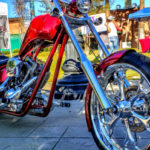Harley-Davidson Softail
From Wikipedia, the free encyclopedia:
In Harley-Davidson motorcycles, the softail frame is designed to look like the hardtail bikes of the past, while still offering the comfort of rear suspension. The shock absorbers are positioned along the axis of the motorcycle, tucked away under the transmission.

2011 Harley-Davidson FLSTFB Softail Fat Boy Lo
There are several Harley-Davidson models with the Softail frame, including the Softail Standard, Custom, Springer Softail, Heritage Softail, Heritage Springer, Night Train, Deluxe, Deuce, Fat Boy, the Dark Custom Cross Bones, and the Dark Custom Blackline. These motorcycles have the same engine, transmission and frame with the exception of the Deuce, which has a 2 inches (51 mm) backbone stretch, but differ in the choice of fork, wheels and accessories.
Front forks
The Softail model line has included a number of choices in front fork configurations. Just as the Sportster and Dyna models offer wide-set and narrow-set fork tubes to accommodate different wheel sizes, the Softails feature either the narrow X-type or fat FL-type forks. Historically, they have also offered the Springer leading link forks that are reminiscent of the sprung front-ends that were used prior to the introduction of the Hydra-Glide in 1949. The FXST designation is used when the X-type fork is used or when the Springer fork is used with a 21 inch wheel, while the FLST designation is used when the FL-type fork is used or when the Springer fork is used with a 16 inch wheel.
Engines
The Softail models do not have rubber-mounted engines. This led to more vibration in Evolution-engined Softails than in rubber-mounted Touring or Dyna models with Evolution engines. To compensate for this, current Softail models use a counterbalanced version of the Twin Cam engine instead of the regular Twin Cam engine used in the Touring and Dyna models.
History
Bill Davis, an avid Harley rider and engineer from St. Louis, Mo. designed the softail in the mid-1970s. His first design, which he worked on in 1974 and 1975, had a cantilever swingarm pivoted at the bottom and sprung at the top with the springs and shock absorber hidden under the seat. Upon working out his design, Davis built a prototype based on his 1972 Super Glide. Davis patented his design and contacted Willie G. Davidson, arranging a meeting in August 1976. Davidson was impressed, but made no commitments. Davidson replied six months later, stating that the company would not be able to use the design at the time but was still interested in it.
Davis continued to develop the design, switching the pivot and the springing points around so that the springs and shock absorber were under the frame and the pivot point was at the top of the triangular swingarm. This allowed the traditional Harley-Davidson oil tank to be placed under the seat. Davis attempted to produce the new design independently as the Road Worx Sub-Shock, but the partnership he had put together for this purpose collapsed. Harley-Davidson executive Jeffrey Bleustein contacted Davis shortly afterward and began negotiations to buy Davis’s design. Davis sold his patents, prototype, and tooling to Harley-Davidson in January 1982.[4] After further testing and development, Davis’s design was introduced in June 1983 as the 1984 Harley-Davidson FXST Softail.















2 Comments
San Diego aerial photography · July 3, 2014 at 2:52 am
I see a lot of interesting articles on your website.
You have to spend a lot of time writing, good job!
San Diego homes for sale · March 8, 2015 at 3:33 am
Cool motorcycle!